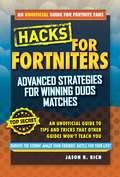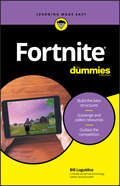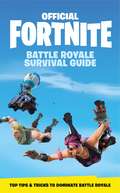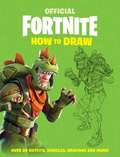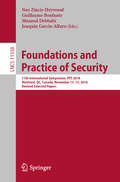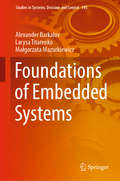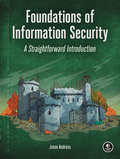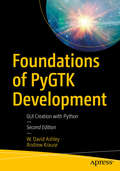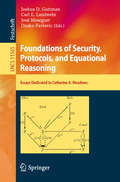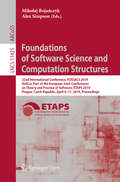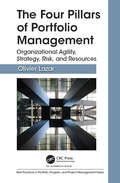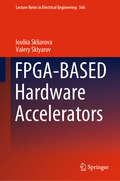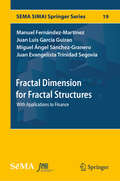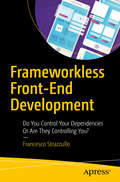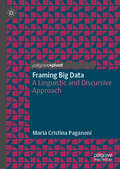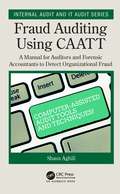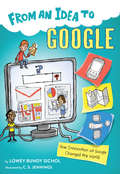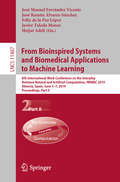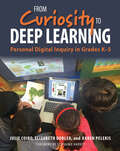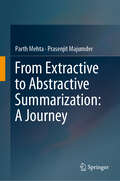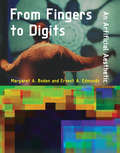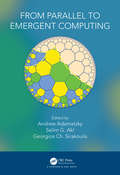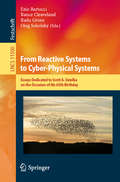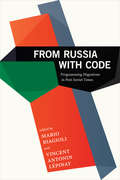- Table View
- List View
Fortnite Battle Royale Hacks: Advanced Strategies for Winning Duos Matches (Fortnite Battle Royale Hacks)
by Jason R. RichFortnite had than 10 million players 2 weeks after its release in September of 2017 and now has more than 40 million players worldwide. The game has 1.2 million likes on Facebook, 1.3 million followers on Instagram, and 1.74 million followers on Twitter.
Fortnite For Dummies
by Bill LoguidicePlay—and survive—in the game of Fortnite! Zombies. Battle. Survival. Fortnite has it all—and if you want to keep your gameplay going until the bitter end to outlast your competition, this book is the ace in your back pocket! Choose a gaming platform Download and optimize the game Play in each of the gameplay modes Scavenge, loot, and collect resources Avoid death and outlast your opponents Who will be the last person standing? When you want to outlast the competition and make Fortnite yours, this book makes it easier than ever to come out on top.
FORTNITE Official: The Battle Royale Survival Guide (Official Fortnite Books)
by Epic GamesThe OFFICIAL Battle Royale Survival Guide from Epic Games, creators of FORTNITE, the BIGGEST gaming brand in the world. Includes all the top tips and tricks you'll need to dominate Battle Royale!From basic gameplay to more advanced maneuvers, this handbook lists all the essential tips and tricks you need to become the last player standing. Immerse yourself in island walk-throughs, weapons rundowns, combat hacks, building guides, team tactics, and more. Featuring:FULL ISLAND GUIDEAll the key places to land and loot--and how to get around the island with easeSNEAKY SURVIVAL TACTICSSmart ways to use the Storm to your benefit, top tips for building your way out of trouble, and the outfit options that offer the best camouflageHOW TO FIGHT BETTER AND SMARTERCrazy and creative ideas for using game elements to your advantage, whether playing solo or in a team
FORTNITE Official: How to Draw
by Epic GamesDraw your favorite Outfits, vehicles, weapons, and more with Epic Games' ONLY official how to draw book, including tips to make your sketches as epic as your in-game achievements and featuring the authentic Fortnite holographic seal. Learn how to draw 35 of the game's most popular icons - including Outfits, weapons, building materials and vehicles. In easy-to-follow stages, you'll go step-by-step from rough sketch to detailed finish. INCLUDES: · 16 iconic Outfits· 8 fearsome weapons· The craziest in-game vehicles· Drawing guide· Top art tips, including advanced shading and texture techniquesWhether you're a complete novice or an experienced artist, this book will inspire you to pick up a pencil and get sketching! LET'S GO!
FORTNITE Official: How to Draw (Official Fortnite Books)
by Epic GamesDraw your favorite Outfits, vehicles, weapons, and more with Epic Games' ONLY official how to draw book, including tips to make your sketches as epic as your in-game achievements and featuring the authentic Fortnite holographic seal.Learn how to draw 35 of the game's most popular icons - including Outfits, weapons, building materials and vehicles. In easy-to-follow stages, you'll go step-by-step from rough sketch to detailed finish. INCLUDES:· 16 iconic Outfits· 8 fearsome weapons· The craziest in-game vehicles· Drawing guide· Top art tips, including advanced shading and texture techniquesWhether you're a complete novice or an experienced artist, this book will inspire you to pick up a pencil and get sketching! LET'S GO!
Foundations and Practice of Security: 11th International Symposium, FPS 2018, Montreal, QC, Canada, November 13–15, 2018, Revised Selected Papers (Lecture Notes in Computer Science #11358)
by Nur Zincir-Heywood Guillaume Bonfante Mourad Debbabi Joaquin Garcia-AlfaroThis book constitutes the revised selected papers of the 11th International Symposium on Foundations and Practice of Security, FPS 2018, held in Montreal, QC, Canada, in March 2018. The 16 full papers, 1 short paper, 1 position paper and 2 invited papers presented in this book, were carefully reviewed and selected from 51 submissions. They cover a range of topics including mobile security; cloud security and big data; IoT security; software security, malware analysis, and vulnerability detection; cryptography; cyber physical security and hardware security; and access control.
Foundations of Embedded Systems (Studies in Systems, Decision and Control #195)
by Alexander Barkalov Larysa Titarenko Małgorzata MazurkiewiczThis book is devoted to embedded systems (ESs), which can now be found in practically all fields of human activity. Embedded systems are essentially a special class of computing systems designed for monitoring and controlling objects of the physical world. The book begins by discussing the distinctive features of ESs, above all their cybernetic-physical character, and how they can be designed to deliver the required performance with a minimum amount of hardware. In turn, it presents a range of design methodologies. Considerable attention is paid to the hardware implementation of computational algorithms. It is shown that different parts of complex ESs could be implemented using models of finite state machines (FSMs). Also, field-programmable gate arrays (FPGAs) are very often used to implement different hardware accelerators in ESs. The book pays considerable attention to design methods for FPGA-based FSMs, before the closing section turns to programmable logic controllers widely used in industry. This book will be interesting and useful for students and postgraduates in the area of Computer Science, as well as for designers of embedded systems. In addition, it offers a good point of departure for creating embedded systems for various spheres of human activity.
Foundations of Information Security: A Straightforward Introduction
by Jason AndressHigh-level overview of the information security field. Covers key concepts like confidentiality, integrity, and availability, then dives into practical applications of these ideas in the areas of operational, physical, network, application, and operating system security.In this high-level survey of the information security field, best-selling author Jason Andress covers the basics of a wide variety of topics, from authentication and authorization to maintaining confidentiality and performing penetration testing.Using real-world security breaches as examples, Foundations of Information Security explores common applications of these concepts, such as operations security, network design, hardening and patching operating systems, securing mobile devices, as well as tools for assessing the security of hosts and applications. You'll also learn the basics of topics like: • Multifactor authentication and how biometrics and hardware tokens can be used to harden the authentication process • The principles behind modern cryptography, including symmetric and asymmetric algorithms, hashes, and certificates • The laws and regulations that protect systems and data • Anti-malware tools, firewalls, and intrusion detection systems • Vulnerabilities such as buffer overflows and race conditionsA valuable resource for beginning security professionals, network systems administrators, or anyone new to the field, Foundations of Information Security is a great place to start your journey into the dynamic and rewarding field of information security.
Foundations of PyGTK Development: GUI Creation with Python
by W. David Ashley Andrew KrauseThere are only two mainstream solutions for building the graphical interface of Linux-based desktop applications, and GTK+ (GIMP Toolkit) is one of them. It is a necessary technology for all Linux programmers. This book guides the reader through the complexities of GTK+, laying the groundwork that allows the reader to make the leap from novice to professional. Beginning with an overview of key topics such as widget choice, placement, and behavior, readers move on to learn about more advanced issues. Replete with real-world examples, the developer can quickly take advantages of the concepts presented within to begin building his own projects.
Foundations of Security, Protocols, and Equational Reasoning: Essays Dedicated to Catherine A. Meadows (Lecture Notes in Computer Science #11565)
by Joshua D. Guttman Carl E. Landwehr José Meseguer Dusko PavlovicThis Festschrift volume is published in honor of Catherine A. Meadows and contains essays presented at the Catherine Meadows Festschrift Symposium held in Fredericksburg, VA, USA, in May 2019.Catherine A. Meadows has been a pioneer in developing symbolic formal verification methods and tools. Her NRL Protocol Analyzer, a tool and methodology that embodies symbolic model checking techniques, has been fruitfully applied to the analysis of many protocols and protocol standards and has had an enormous influence in the field. She also developed a new temporal logic to specify protocol properties, as well as new methods for analyzing various kinds of properties beyond secrecy such as authentication and resilience under Denial of Service (DoS) attacks and has made important contributions in other areas such as wireless protocol security, intrusion detection, and the relationship between computational and symbolic approaches to cryptography. This volume contains 14 contributions authored by researchers from Europe and North America. They reflect on the long-term evolution and future prospects of research in cryptographic protocol specification and verification.
Foundations of Software Science and Computation Structures: 22nd International Conference, FOSSACS 2019, Held as Part of the European Joint Conferences on Theory and Practice of Software, ETAPS 2019, Prague, Czech Republic, April 6–11, 2019, Proceedings (Lecture Notes in Computer Science #11425)
by Mikołaj Bojańczyk Alex SimpsonThis open access book constitutes the proceedings of the 22nd International Conference on Foundations of Software Science and Computational Structures, FOSSACS 2019, which took place in Prague, Czech Republic, in April 2019, held as part of the European Joint Conference on Theory and Practice of Software, ETAPS 2019.The 29 papers presented in this volume were carefully reviewed and selected from 85 submissions. They deal with foundational research with a clear significance for software science.
The Four Pillars of Portfolio Management: Organizational Agility, Strategy, Risk, and Resources (Best Practices in Portfolio, Program, and Project Management)
by Olivier LazarPortfolio management consists mainly of making decisions about which initiatives to undertake, which initiatives not to pursue, and which resources are to be allocated to which portfolio component. At least, that’s how it is most commonly presented in textbooks and courses. Indeed, it is all of that, but it is also so much more. Portfolio management is, of course, about making these decisions, but, more accurately, it is about making them with the goal of creating value for an organization’s wide population of stakeholders, both internal and external. This value is not only expressed in financial terms but also in social terms. The portfolio should create value for all stakeholders, who thereby support the portfolio organization and enable it to sustain itself. Portfolio management is about the realization of strategic vision, achieving a purpose, and developing an intelligent way of using resources to benefit stakeholders. This requires the ability to find a balance among the different dimensions of portfolio governance and among the constraints constantly shaping and reshaping the business environment. This is what portfolio management is truly about; this is what organizational management is about. The Four Pillars of Portfolio Management: Organizational Agility, Strategy, Risk, and Resources takes readers on a journey navigating the dimensions and constraints to be balanced and integrated as part of the portfolio and organizational decision-making process. By balancing the requirements of strategic alignment with the exposure to risk and by reconciling resource demands with capability, a portfolio manager can develop and sustain an organization despite the constant and dynamic evolution of the business environment. This book explains how to manage portfolios that create the agility all organizations require to survive and thrive.
FPGA-BASED Hardware Accelerators (Lecture Notes in Electrical Engineering #566)
by Iouliia Skliarova Valery SklyarovThis book suggests and describes a number of fast parallel circuits for data/vector processing using FPGA-based hardware accelerators. Three primary areas are covered: searching, sorting, and counting in combinational and iterative networks. These include the application of traditional structures that rely on comparators/swappers as well as alternative networks with a variety of core elements such as adders, logical gates, and look-up tables. The iterative technique discussed in the book enables the sequential reuse of relatively large combinational blocks that execute many parallel operations with small propagation delays. For each type of network discussed, the main focus is on the step-by-step development of the architectures proposed from initial concepts to synthesizable hardware description language specifications. Each type of network is taken through several stages, including modeling the desired functionality in software, the retrieval and automatic conversion of key functions, leading to specifications for optimized hardware modules. The resulting specifications are then synthesized, implemented, and tested in FPGAs using commercial design environments and prototyping boards. The methods proposed can be used in a range of data processing applications, including traditional sorting, the extraction of maximum and minimum subsets from large data sets, communication-time data processing, finding frequently occurring items in a set, and Hamming weight/distance counters/comparators. The book is intended to be a valuable support material for university and industrial engineering courses that involve FPGA-based circuit and system design.
Fractal Dimension for Fractal Structures: With Applications to Finance (SEMA SIMAI Springer Series #19)
by Manuel Fernández-Martínez Juan Luis García Guirao Miguel Ángel Sánchez-Granero Juan Evangelista Trinidad SegoviaThis book provides a generalised approach to fractal dimension theory from the standpoint of asymmetric topology by employing the concept of a fractal structure. The fractal dimension is the main invariant of a fractal set, and provides useful information regarding the irregularities it presents when examined at a suitable level of detail. New theoretical models for calculating the fractal dimension of any subset with respect to a fractal structure are posed to generalise both the Hausdorff and box-counting dimensions. Some specific results for self-similar sets are also proved. Unlike classical fractal dimensions, these new models can be used with empirical applications of fractal dimension including non-Euclidean contexts. In addition, the book applies these fractal dimensions to explore long-memory in financial markets. In particular, novel results linking both fractal dimension and the Hurst exponent are provided. As such, the book provides a number of algorithms for properly calculating the self-similarity exponent of a wide range of processes, including (fractional) Brownian motion and Lévy stable processes. The algorithms also make it possible to analyse long-memory in real stocks and international indexes.This book is addressed to those researchers interested in fractal geometry, self-similarity patterns, and computational applications involving fractal dimension and Hurst exponent.
Frameworkless Front-End Development: Do You Control Your Dependencies Or Are They Controlling You?
by Francesco StrazzulloExplore an alternative method of front-end application development without using frameworks or third-party libraries. This book provides you with the required skills and freedom to consider a “no framework” approach when choosing a technology for creating a new project.You’ll work through the most important issues in a clear and sensible way, using practical methods and tools to gain an understanding of non-functional requirements. This book answers questions on important topics such as state management, making a routing system, creating a REST client using fetch, and reveals the trade-offs and risks associated with choosing the wrong framework or tool for your project, as well as providing sustainable, functional alternatives.Frameworkless Front-End Development breaks down the concept of technical debt and the ways in which a framework can impact the lifespan of a project. Along with gaining a comprehensive and clear guide on coding effectively from scratch without frameworks, you will also learn some principles of technical decision-making. What You'll Learn Review how DOM manipulation worksManage the state of a front-end application with different patternsSafely migrate existing applications to a new framework or to frameworkless codeUse decision-making tools such as a Framework Compass Chart and an Architectural ClashSee how the choice of frameworks can affect the ‘health’ and lifespan of a codebase Who This Book Is For JavaScript developers; technical managers responsible for helping teams choose technology stacks for new projects; consultants intending to refactor existing JavaScript front-end codebases
Framing Big Data: A Linguistic and Discursive Approach
by Maria Cristina PaganoniThis book addresses big data as a socio-technical construct with huge potential for innovation in key sectors such as healthcare, government and business. Big data and its increasingly widespread use in such influential spheres can generate ethically controversial decisions, including questions surrounding privacy, consent and accountability. This book attempts to unpack the epistemological implications of the term ‘big data’, as well as the opportunities and responsibilities which come with it. The author analyses the linguistic texture of the big data narrative in the news media, in healthcare and in EU law on data protection, in order to contribute to its understanding from the critical perspective of language studies. The result is a study which will be of interest to students and scholars working in the digital humanities, corpus linguistics, and discourse studies.
Fraud Auditing Using CAATT: A Manual for Auditors and Forensic Accountants to Detect Organizational Fraud (Internal Audit and IT Audit)
by Shaun AghiliThis book discusses various common occupational and organizational fraud schemes, based on the Association of Certified Fraud Examiners (ACFE) fraud tree and assist fraud examiners and auditors in correctly choosing the appropriate audit tests to uncover such various fraud schemes. The book also includes information about audit test red flags to watch out for, a list of recommended controls to help prevent future fraud related incidents, as well as step-by-step demonstrations of a number of common audit tests using IDEA® as a CAATT tool.
From an Idea to Google: How Innovation at Google Changed the World (From an Idea to)
by Lowey Bundy SicholFrom an Idea to Google is a behind-the-computer-screen look into the history, business, and brand of the world's largest search engine. With humorous black & white illustrations throughout, learn about the company that even earned its own catchphrase: Google it!Today, Google is the number one internet search engine and the most visited website in the world. But a long time ago, two college friends, Larry Page and Sergey Brin, started out with just an idea. Find out more about Google’s history, the business, and the brand in this illustrated nonfiction book! Find out where the name “Google” came from. (Hint: It involves a LOT of zeros!) Discover how Google became the fastest and most popular internet search engine of all time. Explore how Google transformed from a tiny startup (in someone’s garage!) into one of the most powerful companies in the world.
From Bioinspired Systems and Biomedical Applications to Machine Learning: 8th International Work-Conference on the Interplay Between Natural and Artificial Computation, IWINAC 2019, Almería, Spain, June 3–7, 2019, Proceedings, Part II (Lecture Notes in Computer Science #11487)
by José Manuel Ferrández Vicente José Ramón Álvarez-Sánchez Félix de la Paz López Javier Toledo Moreo Hojjat AdeliThe two volume set LNCS 11486 and 11487 constitutes the proceedings of the International Work-Conference on the Interplay Between Natural and Artificial Computation, IWINAC 2019, held in Almería, Spain,, in June 2019. The total of 103 contributions was carefully reviewed and selected from 190 submissions during two rounds of reviewing and improvement. The papers are organized in two volumes, one on understanding the brain function and emotions, addressing topics such as new tools for analyzing neural data, or detection emotional states, or interfacing with physical systems. The second volume deals with bioinspired systems and biomedical applications to machine learning and contains papers related bioinspired programming strategies and all the contributions oriented to the computational solutions to engineering problems in different applications domains, as biomedical systems, or big data solutions.
From Curiosity to Deep Learning: Personal Digital Inquiry in Grades K-5
by Julie Coiro Elizabeth Dobler Karen PelekisFrom Curiosity to Deep Learning: Personal Digital Inquiry in Grades K-5 reveals the powerful learning that results when you integrate purposeful technology into a classroom culture that values curiosity and deep learning. The centerpiece of this practical guide is Personal Digital Inquiry (PDI), a framework developed by Julie Coiro and implemented in classrooms by her co-authors, Elizabeth Dobler and Karen Pelekis. Clear, detailed examples offer ideas for K-5 teachers and school librarians to support their teaching.Personal emphasizes the significance of the personal relationship between teachers and students, and the role that students have in the learning process. Digital reflects the important role that digital texts and tools have come to play in both learning and teaching with inquiry. Inquiry lies at the core of PDI, because learners grow and change with opportunities to identify problems, generate personal wonderings, and engage in collaborative dialogue, making learning relevant and lasting.From Curiosity to Deep Learning: Personal Digital Inquiry in Grades K-5 shows you how to integrate inquiry with a range of digital tools and resources that will create a dynamic classroom for both you and your students.
From Extractive to Abstractive Summarization: A Journey
by Parth Mehta Prasenjit MajumderThis book describes recent advances in text summarization, identifies remaining gaps and challenges, and proposes ways to overcome them. It begins with one of the most frequently discussed topics in text summarization – ‘sentence extraction’ –, examines the effectiveness of current techniques in domain-specific text summarization, and proposes several improvements. In turn, the book describes the application of summarization in the legal and scientific domains, describing two new corpora that consist of more than 100 thousand court judgments and more than 20 thousand scientific articles, with the corresponding manually written summaries. The availability of these large-scale corpora opens up the possibility of using the now popular data-driven approaches based on deep learning. The book then highlights the effectiveness of neural sentence extraction approaches, which perform just as well as rule-based approaches, but without the need for any manual annotation. As a next step, multiple techniques for creating ensembles of sentence extractors – which deliver better and more robust summaries – are proposed. In closing, the book presents a neural network-based model for sentence compression. Overall the book takes readers on a journey that begins with simple sentence extraction and ends in abstractive summarization, while also covering key topics like ensemble techniques and domain-specific summarization, which have not been explored in detail prior to this.
From Fingers to Digits: An Artificial Aesthetic (Leonardo)
by Margaret A. Boden Ernest A. EdmondsEssays on computer art and its relation to more traditional art, by a pioneering practitioner and a philosopher of artificial intelligence.In From Fingers to Digits, a practicing artist and a philosopher examine computer art and how it has been both accepted and rejected by the mainstream art world. In a series of essays, Margaret Boden, a philosopher and expert in artificial intelligence, and Ernest Edmonds, a pioneering and internationally recognized computer artist, grapple with key questions about the aesthetics of computer art. Other modern technologies—photography and film—have been accepted by critics as ways of doing art. Does the use of computers compromise computer art's aesthetic credentials in ways that the use of cameras does not? Is writing a computer program equivalent to painting with a brush?Essays by Boden identify types of computer art, describe the study of creativity in AI, and explore links between computer art and traditional views in philosophical aesthetics. Essays by Edmonds offer a practitioner's perspective, considering, among other things, how the experience of creating computer art compares to that of traditional art making. Finally, the book presents interviews in which contemporary computer artists offer a wide range of comments on the issues raised in Boden's and Edmonds's essays.
From Parallel to Emergent Computing
by Georgios Sirakoulis Andrew Adamatzky Selim AklModern computing relies on future and emergent technologies which have been conceived via interaction between computer science, engineering, chemistry, physics and biology. This highly interdisciplinary book presents advances in the fields of parallel, distributed and emergent information processing and computation. The book represents major breakthroughs in parallel quantum protocols, elastic cloud servers, structural properties of interconnection networks, internet of things, morphogenetic collective systems, swarm intelligence and cellular automata, unconventionality in parallel computation, algorithmic information dynamics, localized DNA computation, graph-based cryptography, slime mold inspired nano-electronics and cytoskeleton computers. Features Truly interdisciplinary, spanning computer science, electronics, mathematics and biology Covers widely popular topics of future and emergent computing technologies, cloud computing, parallel computing, DNA computation, security and network analysis, cryptography, and theoretical computer science Provides unique chapters written by top experts in theoretical and applied computer science, information processing and engineering From Parallel to Emergent Computing provides a visionary statement on how computing will advance in the next 25 years and what new fields of science will be involved in computing engineering. This book is a valuable resource for computer scientists working today, and in years to come.
From Reactive Systems to Cyber-Physical Systems: Essays Dedicated to Scott A. Smolka on the Occasion of His 65th Birthday (Lecture Notes in Computer Science #11500)
by Ezio Bartocci Rance Cleaveland Radu Grosu Oleg SokolskyThis Festschrift is in honor of Scott A. Smolka, Professor in the Stony Brook University, USA, on the occasion of his 65th birthday. Scott A. Smolka made fundamental research contributions in a number of areas, including process algebra, model checking, probabilistic processes, runtime verification, and the modeling and analysis of cardiac cells, neural circuits and flocking behaviors. He is perhaps best known for the algorithm he and Paris Kanellakis invented for checking bi-simulation. The title of this volume From Reactive Systems to Cyber-Physical Systems reflects Scott's main research focus throughout his career. It contains the papers written by his closest friends and collaborators. The contributions cover a wide spectrum of the topics related to Scott's research scientific interests, including model repair for probabilistic systems, runtime verification, model checking, cardiac dynamics simulation and machine learning.
From Russia with Code: Programming Migrations in Post-Soviet Times
by Mario Biagioli Vincent Antonin LépinayWhile Russian computer scientists are notorious for their interference in the 2016 US presidential election, they are ubiquitous on Wall Street and coveted by international IT firms and often perceive themselves as the present manifestation of the past glory of Soviet scientific prowess. Drawing on over three hundred in-depth interviews, the contributors to From Russia with Code trace the practices, education, careers, networks, migrations, and lives of Russian IT professionals at home and abroad, showing how they function as key figures in the tense political and ideological environment of technological innovation in post-Soviet Russia. Among other topics, they analyze coders' creation of both transnational communities and local networks of political activists; Moscow's use of IT funding to control peripheral regions; brain drain and the experiences of coders living abroad in the United Kingdom, United States, Israel, and Finland; and the possible meanings of Russian computing systems in a heterogeneous nation and industry. Highlighting the centrality of computer scientists to post-Soviet economic mobilization in Russia, the contributors offer new insights into the difficulties through which a new entrepreneurial culture emerges in a rapidly changing world. Contributors. Irina Antoschyuk, Mario Biagioli, Ksenia Ermoshina, Marina Fedorova, Andrey Indukaev, Alina Kontareva, Diana Kurkovsky, Vincent Lépinay, Alexandra Masalskaya, Daria Savchenko, Liubava Shatokhina, Alexandra Simonova, Ksenia Tatarchenko, Zinaida Vasilyeva, Dimitrii Zhikharevich
